« on: June 02, 2020, 03:03:30 PM »
Eduard 1/48th scale SE5a Hispano Suiza REVIEWED BY David WilsonScale:1/48th
REVIEWED BY David WilsonScale:1/48th
Item #: 82132 Profipack Edition
Price: $A41.95 in Australia. Weekend edition £11.83 from Hannants of UK.
Stockist:Profipack OOP but available through Ebay and numerous quality hobby retailers worldwide.
Contents:114 parts in grey plastic on two sprues plus clear parts sprue; five decal options; colour photo etch set; painting masks.
Comment:
If the Sopwith Camel is regarded by many as the Spitfire of WW1, then the SE5a was surely that war’s Hawker Hurricane. It was strong, dependable, a reliable workhorse and a stable gun platform favoured by many of the Royal Flying Corps’ best pilots.
It was arguably the Royal Aircraft Factory’s best design and in some aspects performed better than the Camel. After initial problems with the Hispano-Suiza engines fitted to the first machines in 1917, the SE5a was upgraded to a higher performance Wolseley Viper, a British-made variant of the Hisso engine and in it was this configuration that the SE5a found its widest fame and success.
The SE5a went on to equip 30 squadrons in the RFC/ RAF and also equipped the Australian Flying Corps as well as seeing service in Canada, Chile, Ireland, Poland, South Africa and the USA among others.
The cream of the RFC flew SE5a’s, among them Albert Ball, Mick Mannock, James McCudden, Cecil Lewis and Andrew Beauchamp-Proctor.
Thus the Royal Aircraft Factory SE.5a is credited with being one of the best fighter aircraft of World War I.
The SE.5 entered service with No.56 Sqn RFC, during April 1917 and was later upgraded to the more prolific SE5a which was produced by six aircraft manufacturers. More than 5000 SE5as were manufactured.
Eduard’s model
The SE5a is this reviewer’s favourite aircraft of WW1. There’s something visually irresistible about its square, boxy look, with its long nose boasting a blunt vintage car-like radiator. The unorthodox armament of a single synchronised Vickers in the fuselage and a Lewis on a Foster mount atop the top wing just adds to the quirky visual appeal.
Model kits of the SE5a date back almost to the dawn of plastic modelling, certainly in 1/48th scale the type was among Aurora’s pioneering line in the 1950s. The mould has been adapted and upgraded by numerous manufacturers ( Monogram among them) and can still be found. The British company Merit’s WW1 line in the early 1960s included the SE5a.
Lindberg also did an SE5a in 1/48th as did Blue Max while in 1/72nd scale Revell’s SE5a from the 1960s was very popular. Esci also did the kit in this scale as did Roden in recent times. Roden also gave us SE5a’s in 1/48th scale (which until now were the best SE kits in this scale) and produced both the Hisso and Viper engine variants in 1/32nd scale. Most recently Wingnut Wings delivered the definitive 1/32nd scale Hisso engine version while Merit ( not the original British company) produced a 1/24th scale kit.
Eduard were a surprisingly late starter in producing an SE5a. When WW1 modelling fell into something of a slump in the early 1990s, it was Eduard that saved WW1 modelling from extinction with its ground-breaking range of 1/48th kits.
In more recent times Eduard broadened its focus toward other subjects but the company has never lost its touch for WW1 subjects and has delivered us new tool kits and a host of reissues with new decals. It’s a great time to be a WW1 modeller.
Eduard’s SE5a first issued in 2017 was its way of marking the centenary of the SE5a entering service in 1917. This Hispano- engine variant was released in 2018.



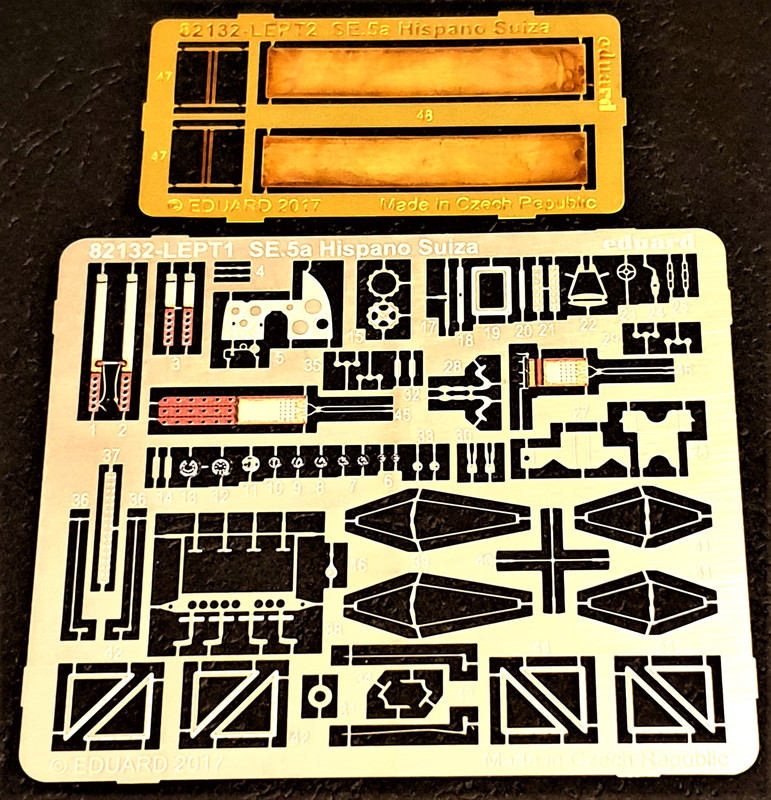
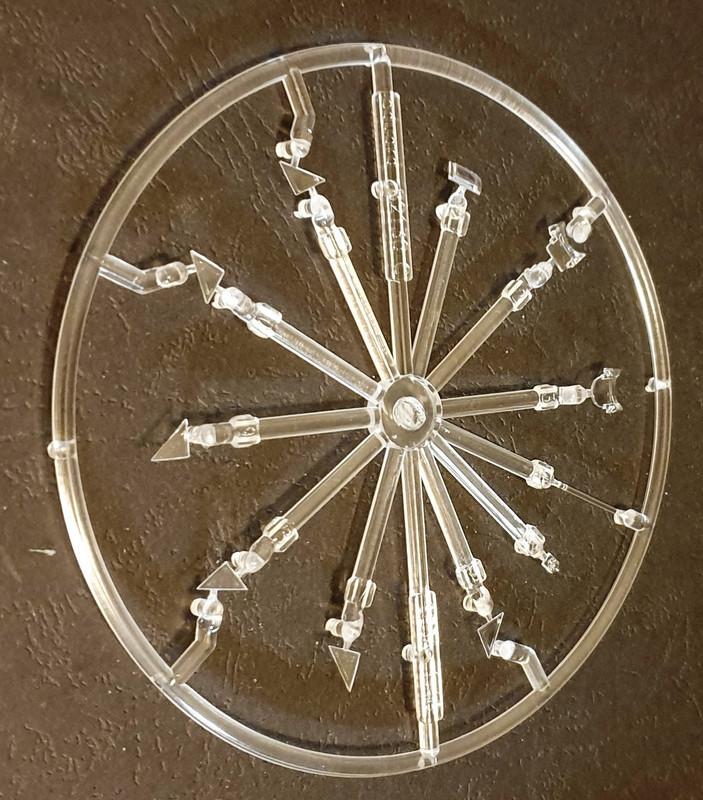
The level of detail in Eduard’s WW1 toolings is impressive, capturing incredibly subtle fabric detail, rib tapes on the wings, complete Hispano-Suiza engine and comprehensive cockpit items – impressive in this scale.
The single piece wings feature separate control surfaces while the struts are nicely in scale and not overdone. The Vickers and Lewis guns are nicely represented, but for the detailers Eduard also provides them and other SE5a features (radiator, props, wheels etc) with separately sold Brassin resin replacements which are astonishing in their nuanced fine detail.
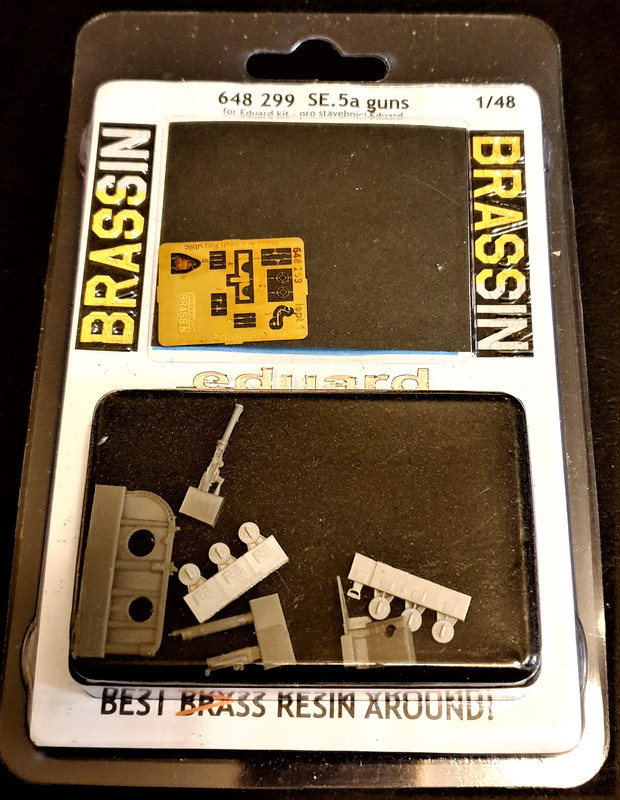
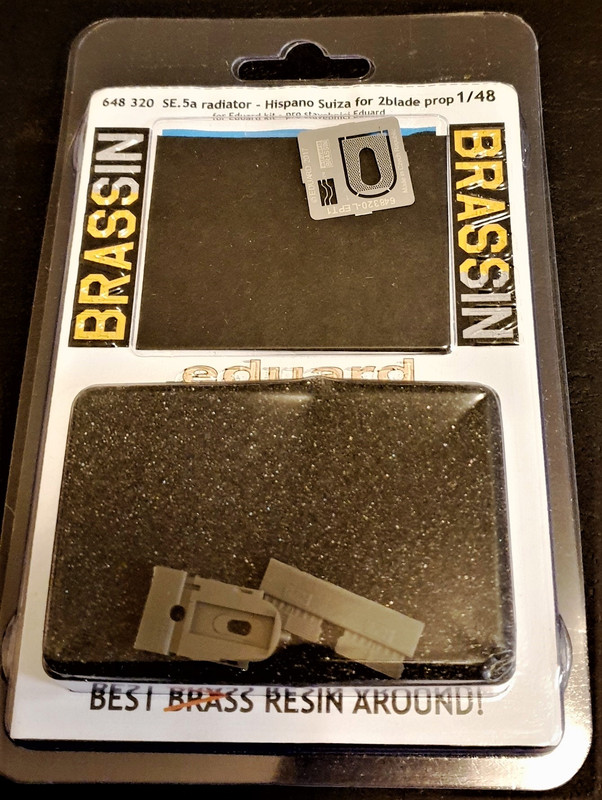
An in depth exploration of the contents reveals new gems with every look. Optional headrests (some aircraft had them, some did not); engine covers; windscreens; different propellers – two and four blade types. The list goes on.
The photo etch frets contain a wealth of small details which cover wing inspection hatch frames, cockpit parts, various exhaust fittings. A lot of thought has obviously gone into the PE fret. The photo etch adds a new level of detail with the colour parts including a finely detailed instrument panel and instruments plus seat belts among the many featured items. A self-adhesive, pre-cut masking set is also included.
One niggle involves the wheels. Detail on the kit wheel covers is basic at best and this is one part that could benefit from the Brassin aftermarket items.
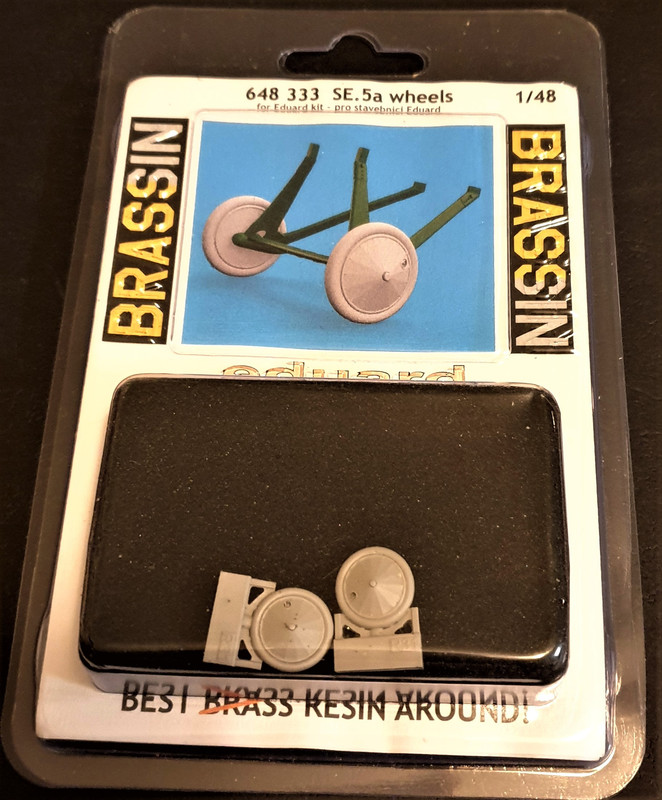
The instructions booklet is a well illustrated 20 page A5 format with each step clearly illustrated with exploded view line drawings which also clearly indicate optional parts depending on which version and markings the modeller chooses to make.
The full colour instruction booklet details the build in very clearly illustrated steps.
Colours are keyed to the Gunze/ Mr Color range. A wider range of paint brands would be appreciated. Vallejo and Humbrol for personal preference.
Clear rigging diagrams are also provided in the instructions.
Marking options and Decals

Five decal options are provided.
• SE.5A D5969, Lt. H.C.R. Lagresse, No. 29 Squadron, St. Omer, France, June 1918
• SE.5A C5303, Lt. L.N. Franklin, No. 56 Squadron, Baizieux, France, March 1918
• SE.5A D3511, Maj. R.S. Dallas, No. 40 Squadron, Bruay Airfield, France, May 1918
• SE.5A F5910, Lt. W.G. Claxton, No. 41 Squadron, Lealvillers, France, February 1918
• SE.5A C9539, Lt. H.G. Forrest, No. 2 Squadron, Australian Flying Corps, Savy-Berlette, France, March 1918.
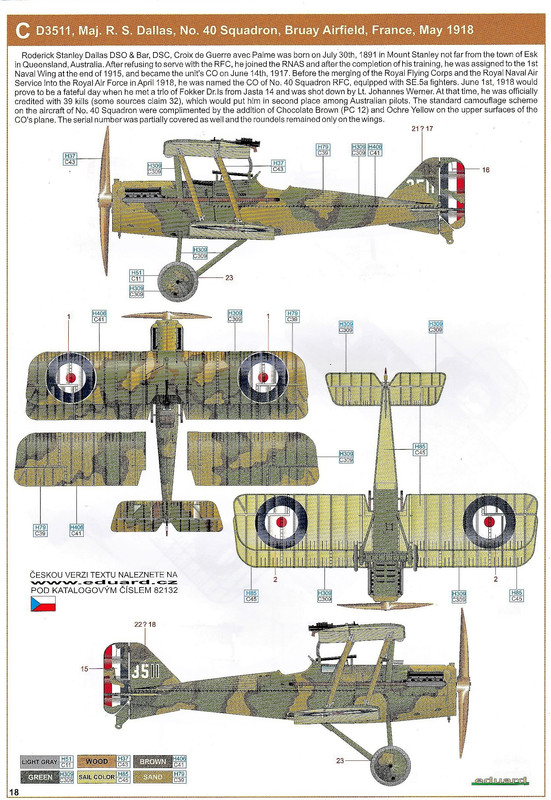
The marking option for Major Stan Dallas, an ace from Queensland, Australia (where our forum is based!) makes this kit doubt appealing and with his unique camouflage colour scheme, Dallas’ machine will be the subject of a planned Eduard build log on the Forum.
Incidentally Eduard has also released a Weekend edition kit featuring the Dallas scheme which can still be found at quality model shops.
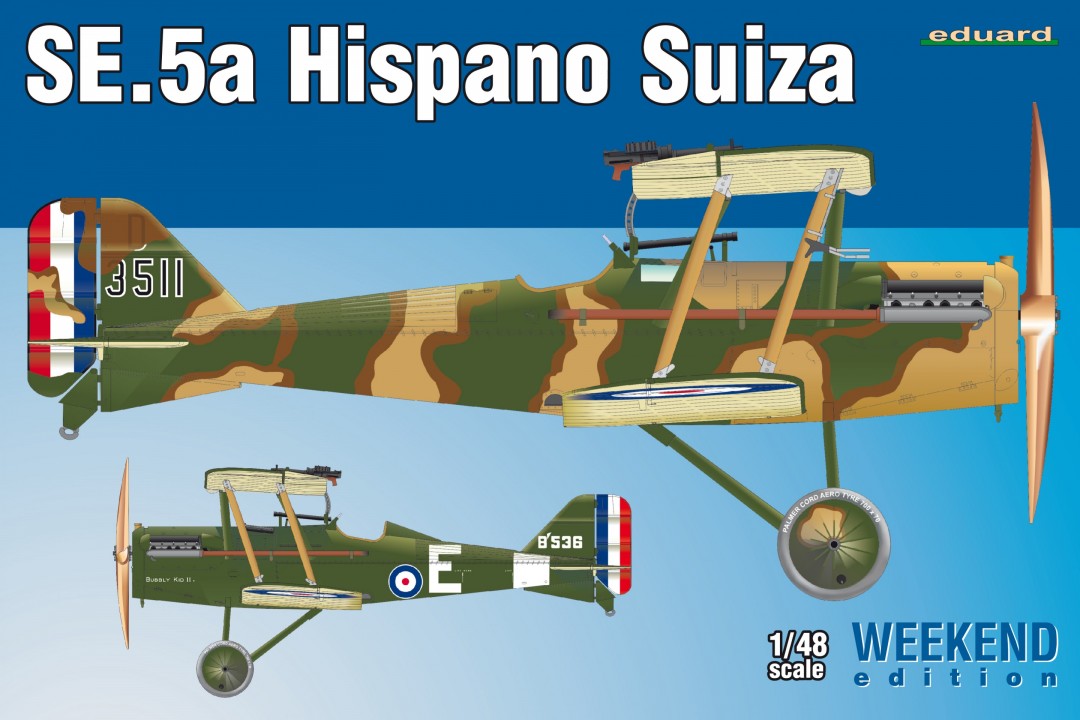
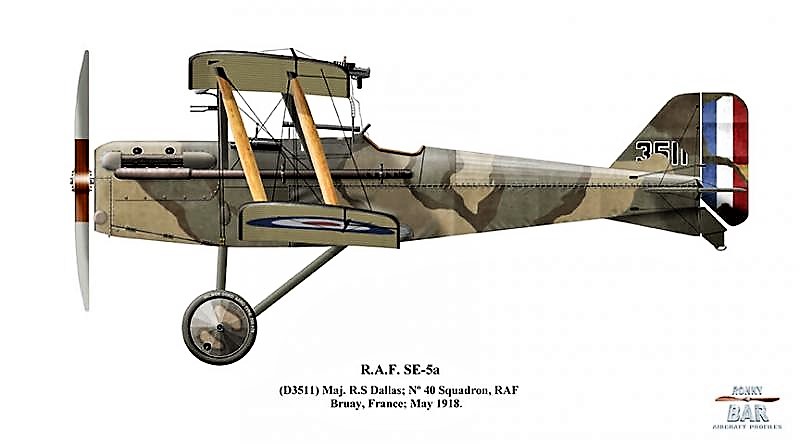
Decal quality looks excellent and in perfect register as you would expect of Cartograf decals.
Summary:
Eduard delivers a state of the art SE5a that exudes quality. Easily the best 1/48th SE5a kit on the market and a must-have for SE5a enthusiasts. Highly recommended.
Verdict:
Highly Recommended.
(Review sample kindly supplied by Eduard. Please support the businesses that support this Forum.)

Logged
Owner and Administrator of ww1aircraftmodels.com and forum.ww1aircraftmodels.com